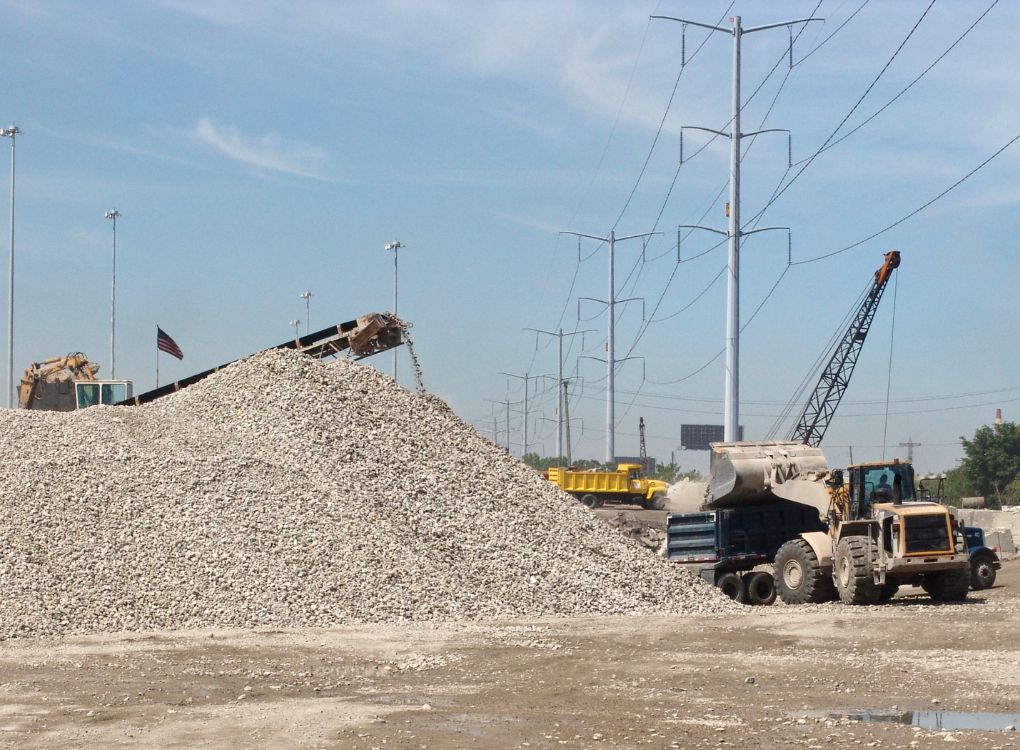In recent years, there has been a growing interest in the use of recycled concrete in construction projects. This is partly due to the increasing awareness of the environmental impact of construction and the need to find more sustainable solutions.
However, there are also some challenges associated with recycling of concrete, such as the need for specialized equipment and expertise. In this article, we will explore the benefits and challenges of recycling concrete and discuss some of the latest developments in this field.
What is Recycling Concrete?
Recycling concrete refers to the process of converting waste concrete into reusable material. This practice involves breaking down concrete into smaller pieces, removing any contaminants, and then using the resulting material as a base for new construction projects.
The benefits of recycling concrete are numerous, including reducing landfill waste, conserving natural resources, and lowering greenhouse gas emissions. Additionally, recycled concrete is often more affordable than virgin materials, making it an attractive option for builders and contractors.
Importance of Recycling Concrete
Recycling concrete is important for several reasons, including:
- Environmental benefits: Recycling of concrete reduces the amount of waste that goes to landfills, which helps to conserve landfill space and reduce the environmental impact of waste disposal. Recycling also reduces the need for new construction materials, which helps conserve natural resources and reduce the carbon footprint of the construction industry.
- Economic benefits: Recycling concrete can be a cost-effective alternative to using new construction materials. This can help reduce the cost of construction projects and make them more affordable for builders and contractors.
- Sustainable development: Concrete recycling is an important aspect of sustainable development, which seeks to balance economic growth with environmental protection and social responsibility. By recycling concrete, we can create a more sustainable construction industry that meets the needs of the present without compromising the ability of future generations to meet their own needs.
- Reduced transportation costs: By recycling concrete on site, transportation costs can be reduced, as there is no need to transport waste to a landfill or a recycling facility.
History of Concrete Recycling
The concept of concrete recycling has been around for several decades. In the 1970s, the construction industry began to explore ways to reuse concrete waste as disposal costs and environmental concerns became issues that are more pressing. The first concrete recycling plants were established in Germany in the early 1980s, and the practice soon spread to other European countries and the United States.
In the 1990s, the use of recycled concrete gained popularity as a sustainable alternative to traditional construction materials. By 1998, the US Environmental Protection Agency had released guidelines for the use of recycled concrete in construction, and the practice had become more widely adopted.
Today, concrete recycling is a common practice in many countries around the world, and the industry continues to innovate and develop new technologies to improve the quality and efficiency of the process.
How Concrete is Recycled?
The process of recycling concrete typically involves the following steps:
- Collection: The first step is to collect the concrete waste from construction sites or demolition sites. The concrete is typically broken down into smaller pieces using a demolition hammer or excavator.
- Sorting: The next step is to sort the concrete waste by size and quality. The larger pieces are typically crushed into smaller pieces using a jaw or impact crusher. The smaller pieces are then sorted by size using screening equipment.
- Removal of contaminants: Once the concrete has been sorted, any contaminants such as wood, metal, or plastic are removed using magnets and other equipment.
- Crushing and screening: The concrete is then crushed and screened to produce a uniform size and shape. This process can be done on-site using mobile crushers and screens or at a recycling facility.
- Washing: If necessary, the crushed concrete may be washed to remove any remaining contaminants.
- Reuse: The recycled concrete can be used in a variety of applications, such as road base, drainage , and construction.
Benefits of recycling concrete
Environmental benefits
Recycling concrete offers numerous environmental benefits. For one, it reduces the amount of waste sent to landfills, which in turn reduces greenhouse gas emissions and the environmental impact of landfill sites.
Additionally, conserves natural resources by reducing the need for new materials and the energy required to produce them.
This also helps to reduce the carbon footprint of construction projects. Moreover, It can help mitigate the environmental impact of quarrying and mining for raw materials.
Overall, the environmental benefits of this process are clear, making it an important part of sustainable construction practices.
Economic benefits
In addition to its environmental benefits, recycling concrete also offers economic benefits.
By using recycled concrete in construction projects, builders can reduce their costs for materials and disposal fees.
This is because recycled concrete is often less expensive than new materials, and it eliminates the need to transport waste to landfills.
Furthermore, recycling of concrete can create job opportunities in the recycling industry, contributing to local economies.
By reducing costs and creating jobs, concrete recycling can be a win-win for both the environment and the economy.
Social benefits
Concrete recycling also offers social benefits.
By reducing the amount of waste that is sent to landfills, recycling of concrete helps reduce the negative impacts of waste on local communities.
This can lead to improved health and quality of life for residents living near landfills.
Additionally, using recycled concrete in construction projects can help create more durable and resilient structures, which can improve safety for those who use them.
Overall, the social benefits of concrete recycling are an important consideration for builders and communities alike.
Durability and strength:
Recycled concrete is often used as a base material for new construction projects.
It has been found to be just as strong and durable as traditional construction materials, which means that it can be used in a variety of applications.
Energy savings:
It requires less energy than mining and processing new materials.
This helps to reduce greenhouse gas emissions and conserve natural resources.
Flexibility
Recycled concrete can be used in a variety of ways, including roads, dams, and bridges.
It can also be used in foundation construction and for concrete cores in buildings.
Read Also: Admixtures In Concrete – Different Types And Functions
Challenges in Recycling Concrete
Recycling of concrete can be a challenging process due to various factors, including:
1. Contaminants: The presence of contaminants in the concrete, such as steel, wood, and plastic, can make it difficult to recycle. These contaminants must be removed before the concrete can be reused.
2. Quality: The quality of recycled concrete can vary depending on the source of the material and the processing methods used. This can make it difficult to use recycled concrete in certain applications where high-quality concrete is required.
3. Cost: It can be expensive, particularly if the concrete has to be transported to a recycling facility. The cost of processing the concrete can also be high, which can make it less economically viable than using traditional construction materials.
4. Availability: The availability of recycled concrete can vary depending on the location and the demand for the material. This can make it difficult for contractors and builders to find a reliable source of recycled concrete.
5. Regulations: There may be regulations and restrictions on the use of recycled concrete in certain applications. This should be discussed with the contractor prior to using recycled concrete in your project.
Equipment for Concrete Recycling:
Concrete recycling requires specialized equipment to crush, sort, and process the concrete waste. The following equipment is commonly used for recycling of concrete:
- Jaw crushers: These are used to break down large chunks of concrete into smaller pieces that can be processed by other equipment.
- Impact crushers: These crushers are used to break down concrete into smaller pieces and are often used in conjunction with jaw crushers.
- Cone crushers: These crushers are used to crush concrete into smaller pieces that can be used for road base and other construction projects.
- Screening equipment: This equipment is used to sort the crushed concrete into different sizes for use in various applications.
- Magnets: These are used to remove any metal materials from the concrete waste before it is processed.
- Conveyor systems: These are used to move the concrete waste from one piece of equipment to another.
- Water trucks: These are used to control dust and reduce the amount of airborne particles during the crushing and sorting process.
- Excavators and loaders: These are used to move the concrete , stone, debris, and other material to the final site of use.
Successful Concrete Recycling Projects
There are many successful concrete recycling projects around the world. Here are a few examples:
- The Green Mile Road in Portland, Oregon, USA: This project involved the recycling of 13 miles of concrete pavement into new road base. The recycled material was used to create a stable base for new asphalt pavement, which reduced the cost of the project and saved natural resources.
- The Olympic Stadium in London, UK: The Olympic Village was built using recycled concrete from the old Olympic Stadium, which was demolished to make way for the new stadium. The recycled concrete was used to create the foundations and other structural elements of the village, reducing the need for new construction materials.
- The E6 Motorway in Norway: The E6 Motorway project involved the recycling of 150,000 metric tons of concrete from the old motorway into a new road base. The recycled material was used to create a strong and durable base for the new motorway, which reduced the cost of the project and saved natural resources.
Summary
Concrete recycling is the process of converting concrete waste into new materials that can be used in construction projects. This process involves the use of specialized equipment to crush, sort, and process the concrete waste. The recycled material can be used for road base, new concrete, and other construction projects, reducing the need for new materials and saving natural resources. Some successful concrete recycling projects include the Green Mile Road in Portland, the Olympic Village in London, and the E6 Motorway in Norway. The equipment needed for this process includes jaw crushers, impact crushers, cone crushers, screening equipment, magnets, conveyor systems, water trucks, excavators, and loaders.





